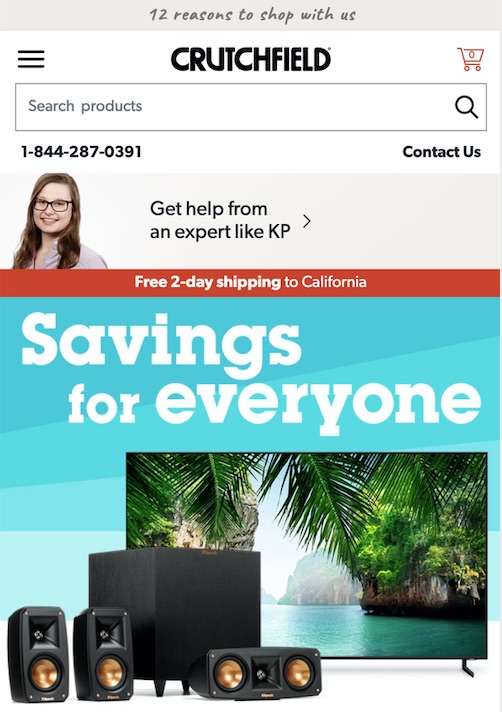Improving mobile performance is a priority for most ecommerce executives, who often obsess over conversion metrics that are typically lower than desktop. But the comparison is not entirely valid. Mobile visitors have different goals. Instead of comparing to desktop activity, merchants should optimize for what mobile visitors are trying to achieve.
In this post, I’ll address solutions to four common obstacles in converting visitors on mobile devices.
… merchants should optimize for what mobile visitors are trying to achieve.
Browse and Bounce
In my experience, the bounce rate for mobile visitors is roughly 10 percent higher than desktop. Time-on-site for mobile users is 33-percent less.
A solution is to realize that you have just a few seconds to make a first impression. Is your value proposition obvious for new mobile visitors? Does your initial page load quickly?
Crutchfield does both of these this well. It presents its value proposition to mobile visitors clearly (“Savings for everyone”) with reasons for them to return, such as expert help, free 2-day shipping, and a prominent phone number.

Crutchfield presents its value proposition to mobile visitors clearly: “Savings for everyone.”
Connect Later
After clicking on an ad, consumers wait 50-percent longer to purchase on a mobile device than a desktop.
To overcome, use email to stay connected with mobile visitors. Most mobile users prefer email. Make email signup prominent for first-time mobile visitors with enticements, such as access to unique content, expert advice, or even a discount. Don’t ask for push notifications right away, and don’t outsource social media engagement. Both perform worse on mobile than on desktops.
There are other ways to rope in shoppers besides signing up for email. On mobile devices, make product and cart sharing obvious alongside the ability to “favorite” items. If a visitor shares a product or cart via email, don’t automatically sign her up for your email list. Earn her trust first. On the next visit, entice her to join your email list. Even better, enclose a discount in the product- or cart-share subject line. The goal is to make the next engagement seamless across mobile devices and desktops.
Hard to Digest
Most responsive sites simply resize content to fit on mobile. But I know from observing hundreds of visitors that digesting information is harder on mobile. For example, a merchant may show the 15 most recent reviews for a product, but reading them is difficult on a mobile device.
To solve, assume you have just 30 seconds to sell someone on your product. What are the three most important pieces of your product pages? Whatever they are, put them at the top of the page. Doing so will increase conversions.
If it’s photos, display multiple images at once instead of a carousel. If it’s reviews, show the most helpful and relevant. Show related categories at the top instead of the bottom.
Completing a Purchase
Navigating and purchasing on a mobile device is flat out harder than on a desktop. Most visitors are in a transient state, such as riding a train or waiting in line, which creates additional obstacles to convert.
To address the difficulty, reduce the amount of info needed to purchase on mobile. Many platforms have made tremendous strides in this regard. PayPal and Google Chrome auto-fill are examples.
But most sellers still require much reading and comprehension. For instance, how obvious is your return policy and shipping details at checkout? How hard is it to chat with someone in real-time, or call you on the phone?
To streamline, make sure your policies are apparent throughout the checkout process, along with your phone number and chat icon. (A phone number is essential on the product page.)
Despite the available shortcuts, over 65 percent of mobile purchasers still have to type their name, address, and credit card number. This is difficult while sitting, much less standing, which is the case with many mobile shoppers.
Create obvious methods for saving and sharing carts so the transaction can be easily completed later, potentially on a desktop.
Also, include technical aides, such as having a keypad for all numeric fields, using Google auto-complete, and providing access to multiple payment methods and payment data entry methods, such as a password manager or on-device wallet.